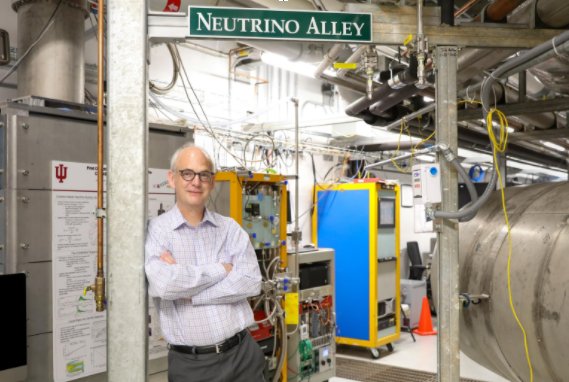For four major neutrino collaborations, ORNL plays key roles. The lab leads the Majorana Demonstrator at the Sanford Underground Research Facility in South Dakota. It hosts the PROSPECT experiment at ORNL’s High Flux Isotope Reactor, or HFIR, and the COHERENT experiment at ORNL’s Spallation Neutron Source, or SNS. HFIR and SNS are DOE Office of Science User Facilities. ORNL is also leading the development of the LEGEND experiment as follow-up to the Majorana Demonstrator.
Neutrinos are a byproduct of neutron production. Each year, hundreds of researchers rely on the 1.4 megawatt pulsed neutron source at SNS, the world’s brightest accelerator-based neutrino source, for scientific research and industrial development. The COHERENT experiment makes the most of SNS’s neutrino factory with five detectors sited along a 164-foot, or 50-meter, long hallway that has come to be called Neutrino Alley.
Here, Demarteau explains its successes and possibilities.
Q: What is Neutrino Alley and how did it come to be?
A: Neutrino Alley is a service corridor at the Spallation Neutron Source that we discovered is ideally suited for neutrino experiments. As SNS’s name says, it is a facility to create neutrons; but in the process, a lot of other particles are created, especially pions. Pions are stopped very quickly in the liquid mercury target and decay at rest to give us three different neutrinos: promptly emitted muon neutrinos with a precise energy, and delayed electron and antimuon neutrinos.
Q: Where is Neutrino Alley in relation to SNS’s target?
A: The closest point in Neutrino Alley is about 20 meters from the SNS target. The irony is that neutrino experiments don’t like neutrons, which are SNS’s primary goal. Neutrons can induce spurious signals that look like neutrino interactions. We need a lot of shielding to remove the neutrons, and that’s why the 20 meters from the target is so beneficial. What’s in between is mainly concrete.
Q: What experiments are going on there now?
A: The COHERENT experiment measures coherent elastic neutrino-nucleus scattering, or CEvNS, which is pronounced “sevens.” This is a collective process in which a neutrino interacts with the nucleus as a whole, rather than with individual components of that nucleus. Eleven neutrino experiments at spallation and reactor sources worldwide are looking for this interaction.
Scientists predicted this process about 50 years ago. However, it has been very difficult to observe because of the small interaction probability and because the energy to be detected is tiny. A frequent analogy is a mosquito bouncing off an elephant and measuring the movement of the elephant. We designed COHERENT to look for this process, and nearly three years ago we were the first to observe it. We provided experimental evidence for the process sought for 50 years. The COHERENT collaboration, comprising 20 institutions from four countries, conducts the experiment at the SNS. Jason Newby is the enthusiastic principal investigator at ORNL, which itself has nearly a dozen participants.
The first target that we used to measure and discover the CEvNS process was a cesium iodide crystal. We have recently also measured this process on argon nuclei; that detector uses liquid argon as the detection medium. Moreover, we have other experiments in preparation – one with a detector of sodium iodide crystals and the other one with a detector of germanium crystals. Measuring the interaction rate for different nuclei provides us with insight into the fundamental physics processes occurring in these target materials.
Q: What questions do you hope to answer with these detectors?
A: The neutrino is one of the more interesting particles in particle physics. Currently, the Standard Model of Particle Physics tells us what matter is made of – quarks and leptons interacting through the electromagnetic, weak nuclear, strong nuclear and gravitational forces. The model was completed in 2012 with the discovery of the Higgs boson.
This model has been extremely successful in enabling us to calculate a lot of the phenomena that we see in nature. We can calculate some phenomena to a precision of better than one in a billion. However, we know that this model is incomplete. One salient new discovery that demonstrates that the Standard Model is incomplete is the fact that neutrinos have mass. Because neutrinos have mass, they can oscillate. They can change identity between the three known types of neutrinos, and that does not fit in our current description of the Standard Model.
The high flux of neutrinos at the SNS also enables us to look for deviations from theoretical predictions, which could point to the existence of a completely new form of matter, such as sterile neutrinos. That would inform our understanding of the origin of dark matter, which would be absolutely transformational. Furthermore, we believe that neutrinos can provide insight into the matter-antimatter asymmetry in the universe. Neutrinos provide a unique window that will help us probe and uncover the new physics that we don’t know yet, that is not part of our Standard Model, our current description. That’s why neutrinos are such fascinating particles to study.
Also, by mapping the fundamentals of neutrino interactions with liquid argon, our measurements inform the flagship Office of High Energy Physics experiment called DUNE, the Deep Underground Neutrino Experiment, which uses liquid argon as the detection medium. One goal of the DUNE experiment is to measure the neutrino flux from a supernova explosion in our galaxy. It just so happens that the energy spectrum of the neutrinos at the SNS is very similar to the energy spectrum expected from a supernova explosion. Our measurements thus provide the foundational measurements to enable extraction of information about the processes inside a supernova explosion.
Q: How has having a neutrino factory been a game changer?
A: The SNS is a game changer because it is a test beam for neutrinos. I can select a single type of neutrino with a well-defined energy with no background to probe a physics phenomenon. The SNS is a pulsed source for neutron production with a repetition rate of 60 hertz. This timing structure, combined with the physics of pion decay, enables me to select background-free, promptly emitted muon neutrinos with a very well-defined energy or a mixture of only electron and muon antineutrinos. This is unique in the world. No other source can provide that. That is the breakthrough that the SNS provides.
Q: Why is it important to have only one flavor of neutrino?
A: In everyday life we constantly deal with noise. How delightful it is to go to the symphony, and before the orchestra starts playing, you can hear a pin drop. Absolute quiet, no noise. And as soon as the orchestra starts playing, you are able to discern every nuance of every instrument for every measure during the performance. That is exactly the environment the SNS provides us: a pure, almost serene environment to study neutrino interactions. A pure muon neutrino source with a well-defined energy, shielded from most neutrons and other backgrounds, that enables you to probe the subtlest of effects of fundamental physics. There’s no other facility in the world that even comes close to providing that unique feature of neutrino physics.
Q: How many neutrinos does COHERENT catch?
A: The other unique feature of Neutrino Alley is the very high flux of neutrinos. Because neutrinos interact very weakly, you need a lot of them to carry out your experiments. The number of neutrinos coming from the SNS is approximately 4.3 ×107 neutrinos per second per square centimeter at a distance of 20 meters from the target. It’s an enormous number. What we end up detecting is a few hundred events. That huge reduction in data gives you a feel for the very small interaction rate of neutrinos. But given that we have such a very large and well-controlled neutrino flux, neutrinos can be used as a portal to other types of physics.
Q: Neutrinos have been the topic of many Nobel Prizes. What more can they show us?
A: Who knows? Neutrinos have surprised us many times before, and I’m convinced that they still have many surprises in store for us. We know that there is dark matter in the universe. We observe its gravitational interaction through the motions of the galaxies, but we have no clue what that is. Neutrinos can provide us clues to what the nature of dark matter really is. If dark matter has a particle nature, it could be that there are other types of neutrinos that we have not discovered yet. So far, we have found only three types of neutrinos, but there may also be other kinds of neutrinos, such as so-called sterile neutrinos. They could be candidate particles to help explain the nature of dark matter. At SNS, with the upcoming Second Target Station, further windows of opportunity will be opened with no impact to the base neutron science program.
Q: What is the future of neutrino research?
A: With the abundant availability and capabilities to study neutrinos, we’ve learned something about their nature. But at the same time, because the flux is so high and the source so pure, we have other windows to the universe.
Neutrinos are fascinating and mysterious particles that we know so little about. For example, we don’t know if a neutrino is its own antiparticle. To probe that property of neutrinos, we are involved in a flagship experiment, called LEGEND – the Large Enriched Germanium Experiment for Neutrinoless double-beta Decay. If we can establish that a neutrino is its own antiparticle, it will tell us something about the matter/antimatter asymmetry in the universe. If the universe started out in equilibrium, there should be equal amounts of matter and antimatter. However, that’s not what we see. We see only matter around us. So, the question that has been plaguing us for a while is, where did all the antimatter go? If a neutrino is its own antiparticle, it provides a mechanism for the antimatter to disappear. That’s another reason neutrinos are thought to be a probe to help us further understand fundamental interactions in nature and, in the end, the energy and matter distribution in the universe.
Resources at the SNS are funded by DOE’s Office of Science.
UT-Battelle manages ORNL for the Department of Energy’s Office of Science, the single largest supporter of basic research in the physical sciences in the United States. The Office of Science is working to address some of the most pressing challenges of our time. For more information, please visit energy.gov/science.



